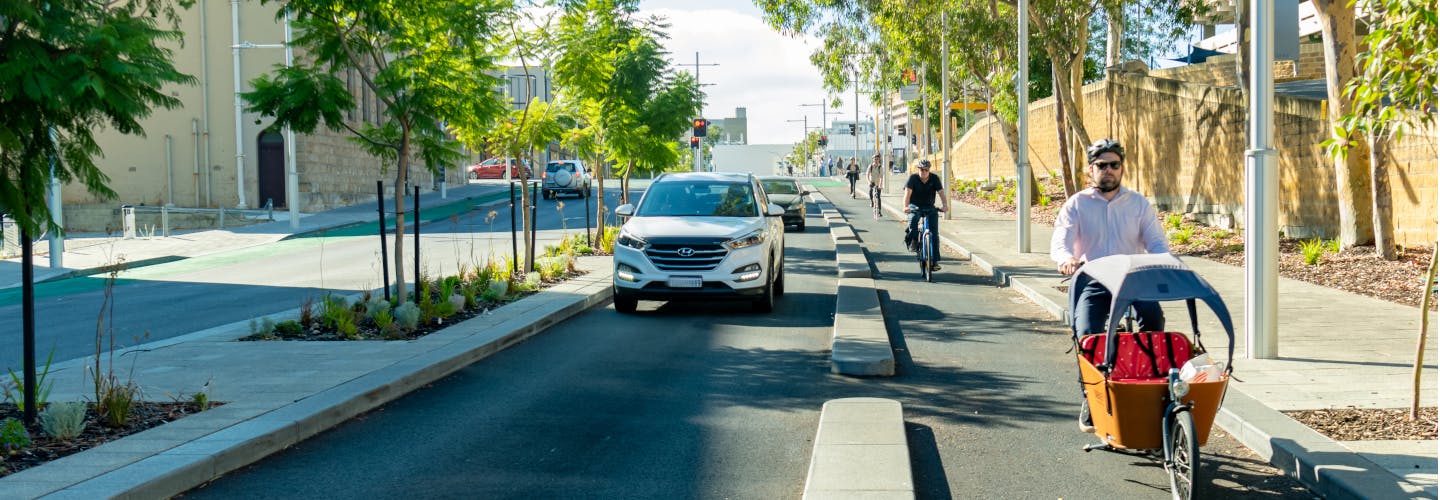FAQs
Why does the City need a bike plan?
There are many health, social, environmental, and economic benefits to encouraging cycling. The City’s previous plan, Cycle Plan 2029, was overdue for an update. This update aligns with a number of the City’s existing strategies.
What area of the City does the draft Bike Plan relate to?
The draft plan applies to all the City of Perth’s 6 (six) neighbourhoods - Central Perth, West Perth, East Perth, Claisebrook, Crawley Nedlands and Northbridge - as indicated in the map below:
What will the survey information be used for?
The information will be used to finalise the City’s Bike Plan and inform future bike planning more generally.
What will happen once the plan is finalised?
The final Bike Plan 2025 – 2035 will be presented to Council for adoption in late 2024. The plan will inform future priority projects including advocacy to agencies such as Main Roads WA, the Public Transport Authority and the Department of Transport.
What bike initiatives are planned for the area around UWA?
The plan will be revised based on any feedback received from the University, other relevant stakeholders and the community.
How does this plan interface with cycling provision through Kings Park?
Transport planning within Kings Park is undertaken by the Botanic Gardens and Parks Authority, who are responsible for the care and management of the park. The City of Perth has recently completed shared paths on Winthrop Avenue and Kings Park Road which will improve access to Kings Park and UWA.
What planning is taking place in the vicinity of the QEII Medical Centre Precinct?
The Department of Transport is currently preparing a QEII Active Mobility Network Improvements Plan. The City will advocate to the Department to complete this work.
Has planning for the Swan River foreshore been taken into account?
The Riverfront Masterplan is currently in progress. Cycling facilities will be included as part of the development of this and any other future plans along the foreshore.
Has the plan taken into account the proposed new primary school in East Perth?
Negotiations on the site of the new school are ongoing. The City will advocate for cycling and walking to be considered in planning for the new school. Further detail can be found on the City’s website: perth.wa.gov.au/building-and-planning/future-perth/major-projects/east-perth-primary-school.
Were neighbouring Local Governments consulted as part of the development of this plan?
The City recognises the need for a seamless cross-border bike network and is committed to working with neighbouring Local Governments on an ongoing basis to ensure this occurs. Meetings were sought with all neighbouring Local Governments and major institutional stakeholders as part of the development of the draft Bike Plan, and all will be given opportunity to comment on the draft.
Does the draft Bike Plan align with the Department of Transport’s Long Term Cycling Network?
The Long Term Cycle Network serves as an aspirational plan to collaborate between State and Local Governments for a continuous network, enhancing transportation, recreation, tourism, and commercial activity.
The proposed network is adaptable, allowing Local Governments to adjust routes as needed due to changing circumstances, including new bike plans.
How does the draft Bike Plan relate to the CBD Transport Plan and Perth City Deal?
Several projects have already been delivered from the CBD Transport Plan, with others currently under investigation. Other plans must align with the City’s new Bike Plan.
What is the City's role in providing for bike riding in the city?
The public realm, including city streets, is under the care and management of the City of Perth.
The term "public realm" refers to the physical and social space that is accessible and open to the general public. It encompasses the shared spaces and environments within a community or urban area that are designed for public use and interaction. The public realm includes various elements such as streets, parks, public squares, and any other areas where people can gather, move, and engage with one another.
State Government agencies such as Main Roads Western Australia (MRWA) also play an important role – typically working in collaboration with local governments – as they are responsible for managing traffic signals (traffic lights, including cycle lanterns) across the road network, as well as regulatory signs and pavement markings, including bike lane markings and bike head start boxes. MRWA has begun developing its Guidelines for Cycle Facilities at Traffic Signals. The City will advocate for these guidelines to be finalised as a matter of urgency.
